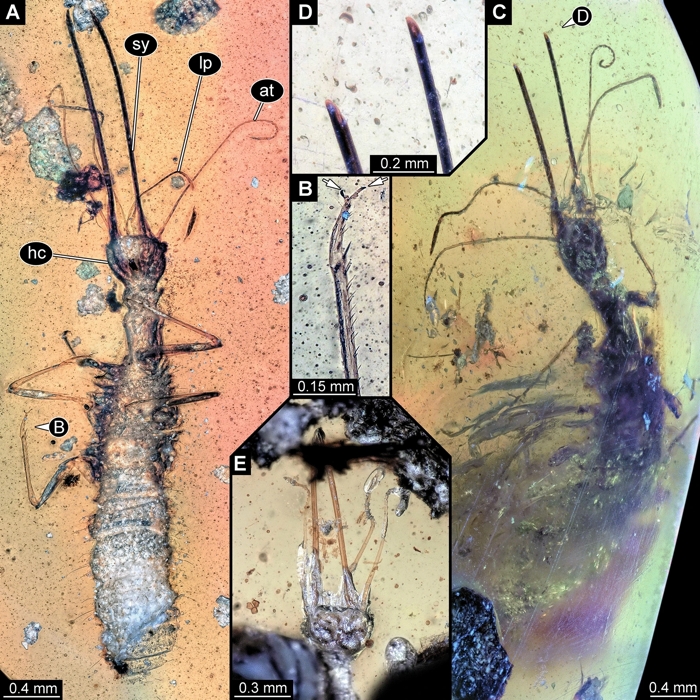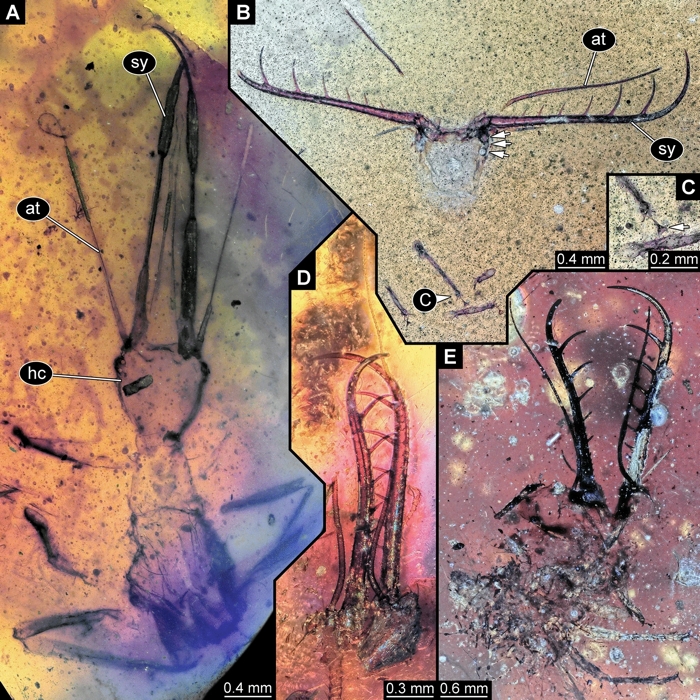Nothing makes for a time capsule quite like amber. Sealed in the golden gloop, ancient life-forms are transported across eternity to the modern day, preserved in impeccable detail, in all their weirdness and glory.
While the use of Burmese amber raises serious and complicated ethical concerns over how it is mined and sold, amber deposits in Myanmar yet represent a vast treasure trove of scientific discovery, showing what all kinds of diverse life looked like almost 100 million years ago.
Sometimes, what they look like is the opposite of what we expect, scientists report in a new study, documenting "extreme morphologies" in the fossilized larvae of ancient lacewings, of the insect order Neuroptera.
Lacewings, along with other kinds of Neuropterans, are part of a superorder of insects called Holometabola (aka Endopterygota), in which the insect undergoes holometabolism – a complete metamorphosis, as its body develops and transitions between each life stage.
"The enormous evolutionary and ecological success of Holometabola has been attributed to the niche differentiation between the adult and the often highly aberrant-appearing larva," explains a team of researchers, led by first author and paleobiologist Joachim Haug from Ludwig Maximilian University of Munich in Germany.
 (Haug et al., Scientific Reports, 2021)
(Haug et al., Scientific Reports, 2021)
Above: Elongated appendages and stylets in Cretaceous lacewing larvae.
Amongst these different life stages, there is a persistent idea in biological circles that the larvae of holometabolans – the immature forms of the insects, before they reach their adult stage – are necessarily undeveloped, worm-like things, having not yet had a chance to grow pronounced features such as eyes, antennae, mouthparts, and legs.
"It also has been suggested that holometabolan larvae are something like early hatched embryos, hence possessing a type of 'not-yet-ready' morphology," the researchers write in their paper.
"All these notions indirectly imply that holometabolan larvae are to a certain degree constrained in their possibilities to evolve morphologically diverse forms."
However, some very old lacewing larvae trapped in time from the late Cretaceous (about 100 million years ago) appear to challenge this line of thinking. Perhaps it is we who are constrained, in our thinking; not the lacewings, in their protruding.
In amber deposits sourced from from the Hukawng Valley, Myanmar, Haug and fellow researchers identified numerous lacewing larvae specimens showing a variety of elongated antennae, jawbones, limbs, trunks, and necks.
In particular, the lacewing larvae studied show straight venom-injecting, piercing-sucking mouthparts that protrude from the jaw, forming what is known as a 'stylet'.
 (Haug et al., Scientific Reports, 2021)
(Haug et al., Scientific Reports, 2021)
Above: Elongated appendages and stylets in Cretaceous lacewing larvae.
"The long stylet may have acted as a means of keeping their wounded victims at a distance until the toxin began to take effect," Haug says, conceding the hypothesis is difficult to investigate now, 100 million years later.
"As in the case of all modern species of lacewings, these larvae were probably predators, but we know nothing about their prey."
Even so, while we can't say for sure just how all these body parts might have functioned (and on whom) in the late Cretaceous, there's enough here to challenge the old argument that creatures like lacewings can only grow such prominent body features in adulthood.
Rather, Haug and his team suggest that the "general pattern" of holometabolan larvae being defined as stubby things with a lack of diverse body parts reflects, in part, scientific ignorance of larval forms, and of how complex they can sometimes be.
If we look 100 million years back, we can see a rare example of that complexity frozen in time – even if for evolutionary reasons, later lacewing larvae might have then lost their pointy bits.
Such an evolutionary loss would help to explain our lack of understanding about immature holometabolans, but that doesn't mean we should underestimate them. Absence of evidence is not, after all, evidence of absence.
"There is no principal constraint that hinders holometabolan larvae to develop such structures," the scientists explain.
"[The specimens here] demonstrate, again, that considering only modern-day fauna will lead to the impression that certain morphological or developmental constraints exist, but which are in fact only artifacts due to 'filtering history'."
The findings are reported in Scientific Reports.
#Nature | https://sciencespies.com/nature/extreme-morphologies-in-ancient-insects-show-how-little-we-know-them-at-all/
No comments:
Post a Comment